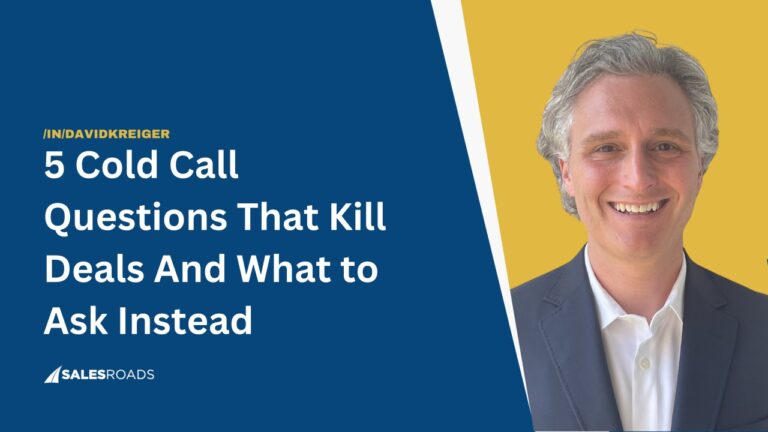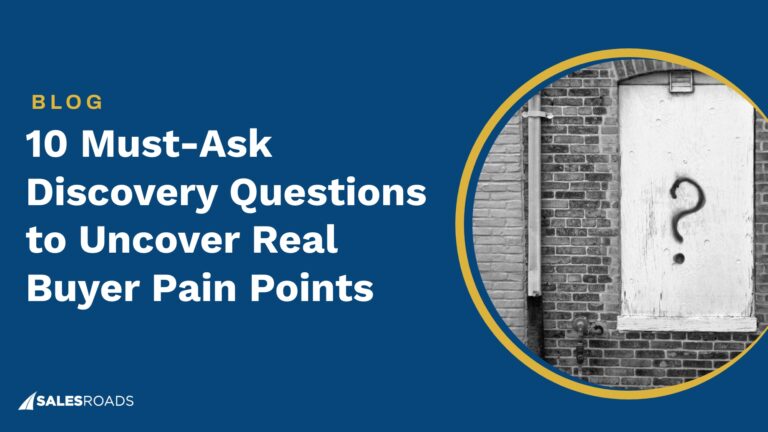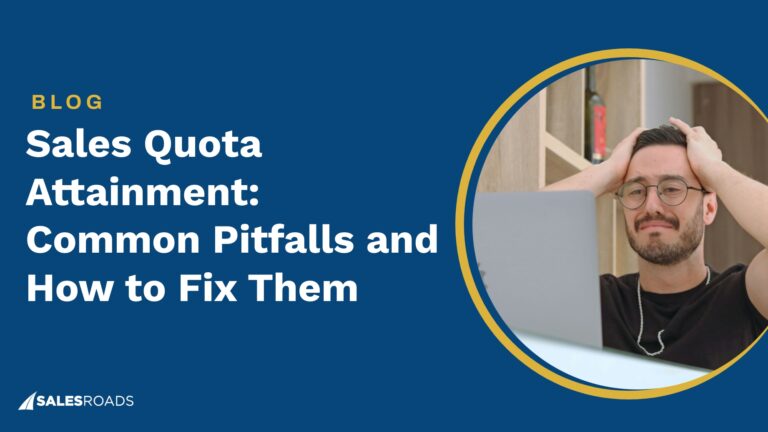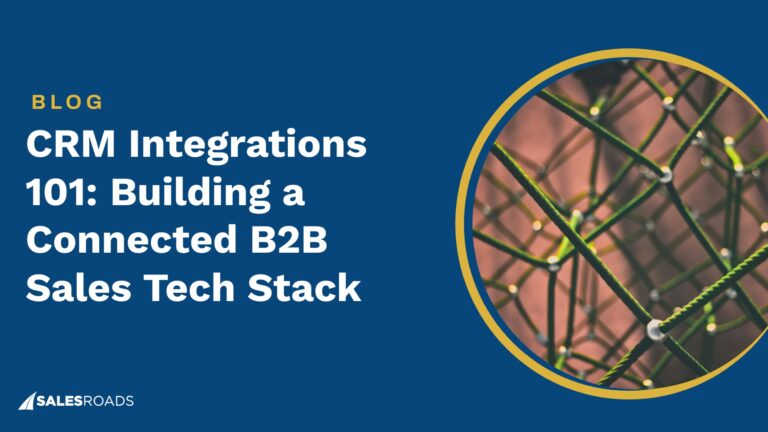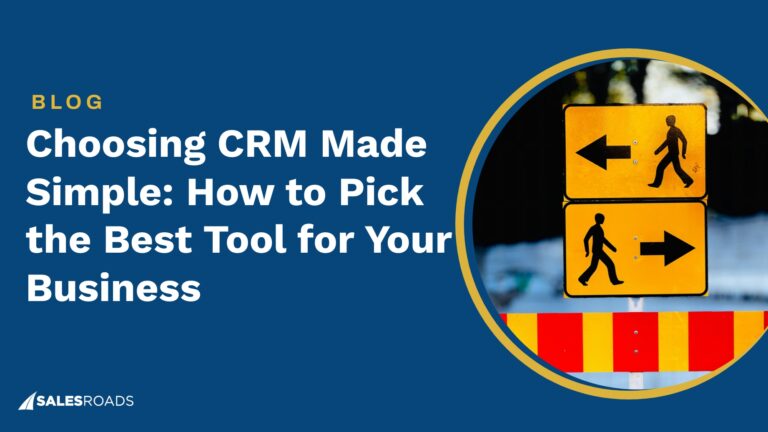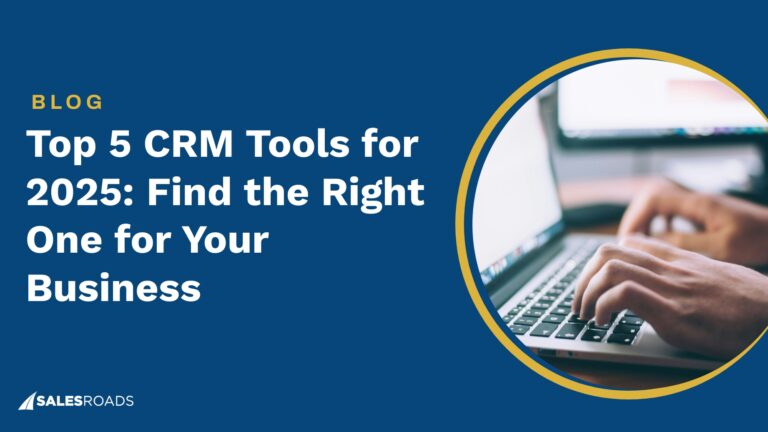Sell Like A Leader – Episode 12
In this episode, we dive into:
– Adoption in the sales cycle: Selling with an adoption mindset, bringing customer success expertise, the new metric of success for salespeople, non-transactional sales processes, preventing wrong expectations, and reducing customer churn.
– Rapid Fire Q&A
About Andy Hershey
David Kreiger chats with Andy Hershey, CRO at Sovos where he leverages his expertise to drive growth as a leader in global tax compliance solutions. Andy has over 23 years of experience in sales and leadership roles across three companies, including Splunk and NS1. At Splunk, he spearheaded the transition from on-premises to SaaS, scaling a $2 million SaaS business to over $1 billion as Global VP.
Podcast Key Takeaways
- Andy highlights the shift from a transactional approach to a customer success-driven strategy. Your sales team should prioritize helping customers understand the value of your solution early in the sales cycle.
- Success isn’t a solo act. Involve customer success and professional services early to accelerate adoption, reduce churn, and close bigger deals. Strategic pairing of sales reps and customer success managers based on account types and skill sets is crucial.
- De-emphasize deep product knowledge and focus on understanding customer pain points and delivering value. Rigorous discovery early in the sales cycle can help tailor the perfect solution for your customers and enhance their overall experience.
Connects
Connect with Andy Hershey: https://www.linkedin.com/in/andyhershey/
Connect with David Kreiger: https://www.linkedin.com/in/davidkreiger/
Subscribe to the podcast and follow our Podcast LinkedIn page so you don’t miss any episodes!
Transcript
David: Welcome to the Sell Like a Leader podcast, the podcast for revenue leaders who are on a mission to cultivate a high-performing sales team within their organization. I'm your host, David Kreiger, founder of SalesRoads, the most trusted lead generation and appointment setting company in the country. Today, we bring you a fantastic revenue leader, Andy Hershey.
Andy has over 23 years of experience in sales and leadership roles across three companies, including Splunk and NS1. At Splunk, he spearheaded the transition from on-premises to SaaS, scaling a $2 million SaaS business to over $1 billion as their Global VP. Now, as the CRO at Sovos, Andy leverages his expertise to drive growth as a leader in global tax compliance solutions.
Andy, thanks so much for being with us today. Welcome to the show.
Andy: [00:01:00] Great to be here. Thanks for inviting me.
David: So what we'd love to talk a little bit about today, which it seems like you have a lot of expertise in and really have driven at your organizations—and I think a lot of sales leaders struggle with this and think about—where do we bridge the gap from sales to customer success?
Um, I think that what you'll find is that not only is it going to increase, you know, the adoption, but accelerate sales cycles and improve conversion rates.
And so what I’d love to talk about is your strategy around adoption in the sales cycle and how you leverage customer success alongside your sales team. And so with that, Andy, could you define at a high level what selling with an adoption mindset is?
Andy: Great question. I think there's a couple ways to look at that. One, I think the traditional way that we've sold for so many years is we'd have a deal, an opportunity, we'd sell that to closure, and we'd run off and chase the next customer.
But what happens is that customer, [00:02:00] we go through a sales cycle when we get a technical win—say, to the IT buyer—and then they get budget from their manager and get approval with process... process…
Then we go through procurement and legal. And I, as a salesperson, I'm excited when I get that win. I'm super excited when I know I'm going to get that deal. But by the time I'm going through procurement and legal and getting beaten up and so forth, I'm getting really burnt out. And it's just more of an obligation.
It's a weight on my shoulders. And it's, you know, weeks and months till that actual order gets placed or PO. Um, and then when it does come in, you know, I chase the next customer or I go back to that technical champion that I sold to. And he says, “Hey, Andy, that’s great. I know your product. I know the value in it, but that was three months ago.
I have four fires now. Let me focus on them and then come back to me and remind me what your product does again. Let's figure out what we can implement and so forth.”
Next thing you know, it's four or five months later. Your PS team is working with that customer to very slowly get onboarded and so forth.
And a year later, they partly adopted. We thought, “Wow, this person would have a lot more onboarding [00:03:00] success and be getting value by now and consuming more of their license.” That’s great—subscription, what's going on here?
So that's kind of the old school, and I think it still happens in many places. We chase the deal, get the PO, off the plate, chase the next one.
And the adoption’s trailing, and the salesperson says, “Well, it’s a CSM, it’s PS,” etc. So, for me, contrasting that is—I think selling with an adoption mindset is really talking not just about the product and solution you're selling, but helping the customer understand the value they're going to gain. And that starts with discovery, for instance, really quantifying the value, assessing the value they can gain from your solution, and asking the right questions early on.
By the way, I think it's super important to ask value questions early on. You know, what's the cost of this? What's the impact of this? You have it—doing it manually today. How many hours per week? If you could get... what would they be doing with higher value?
Oh, this is your infrastructure today. If you do it the way we're talking about, how much would you save?
You know, things like that—and helping them really quantify the value. You’re quantifying [00:04:00] for them that value and presenting it as part of, you know, the CFO selling deck and so forth in a cycle. But just as importantly, really having a clean handoff with CS, engaging your customer success team in the sales cycle and including them in that so that when you close the deal, they take the handoff and they know, “Okay, here's what we're going to do.
Here's what the customer wants to achieve. Let me help the customer achieve this and then quantify the value realized.” Then we have quarterly business reviews and so forth—we can talk about the value the customer is gaining or not gaining, as opposed to bits and bytes and so forth like that.
The other thing I would say, which ties to this point, is in a sales cycle, I would engage PS and CS in the air. I would shift it left. Let’s shift adoption left, from usually post-PO to the left. Let’s have PS, let’s have CS as part of our conversations early on—not just put in a quote, but let's have CS walk in and tell a customer, “Here’s what a success plan at our company looks like.
Here’s what customers need to do right away. Let me work with you, Mr. Customer, Mrs. Customer. A bunch of these things [00:05:00] you can do right now behind the scenes. Let me help you do that so you're prepared to get value.” Doing that helps me differentiate my offering from other competitors, but also it helps ensure these customers get value faster.
Because as we all know, the name of the game is: how can we help our customers accelerate their time to value?
There's a tremendous win-win for the customer and for ourselves when we do it, because the faster they get more value, the sooner they can buy more stuff from us, right? So it's a great natural win-win.
David: When you have reps who haven’t sold with an adoption mindset before, what are some of the things that you really try to convey to them as to why it’s important?
I mean, I think a lot of times, reps might feel that if they get, um, CS involved too early…
First of all, you know, maybe they’re giving up control of the sale, they’re slowing things down, but I think you’ve made some arguments where it actually can speed up the sales cycle.
So what are some of the things that you do or think about with your team to [00:06:00] try to get them to adopt this mindset and not just focus on getting the sale and moving on?
Andy: It’s a great question. I think one point you brought up is just getting credit, right? Giving away, you know, kind of losing control, and so forth. And I think in sales, oftentimes talking to salespeople, you know, let’s get comfortable. Yeah, we’re the quarterback, but we can also be the person behind the scenes in a Broadway play, behind the stage, whispering directions to the actors and so forth.
We don’t have to be center stage for everything. We have to have the right resources that add value come at the right time. And when we do that, that’s a competitive advantage. Any company we go to, there’s always people who add value, and you want to maximize them. And people who say they want to help you close deals and all these things, and actually don’t—they mess things up.
You want to keep them the heck away. But when you have people in CS and PS and product and so forth that can add value and help you win more deals, you should leverage them because they’re going to help you make more money and do bigger deals.
And again, if you can help your customer not only purchase your product, your solution, but adopt it and consume it and get value faster, it’s usually not the first deal that’s the [00:07:00] biggest—it’s the second or third.
You can do more of a platform deal. So like, how do you get to those bigger deals and bigger dollars faster? Land quickly, help them gain value, don’t run away.
Bring those people in early in the sales cycle to help you sell. Stay close to the customer. Even if there is a QBR with customer success, talk to your customer. Be reaching out, you know, just check in. Are you happy? How are things going? That pays off.
As we all know, it’s so much easier to sell to an existing customer than to make a thousand cold calls to find a new customer. Those are the kinds of things we talk about. And, um, it’s simple—you know, so much of the stuff comes back down to the basics.
David: I like how you framed it as the salesperson is the quarterback or, you know, can be kind of the conductor.
It changes the mindset of what they’re doing—they’re not just on the front lines. And it kind of is empowering in a way that you are, you know…
You’ve got these resources.
You need to orchestrate this experience. Because I think sales at its best is an experience for the prospect, right? And you’re orchestrating, you’re guiding them through it. [00:08:00] And when you do that well, that’s when the magic happens and you’re able to figure out what are the issues that they’re having and figure out whether you can or cannot solve them for them.
And so as they are the quarterback and when they are, you know, trying to hand the ball off to customer success…
You said you want to move them left. You want to move them early.
Are there any guidelines for sales leaders who are trying to do this, and they say, “Okay, that sounds right. I don’t want just customer success to come in after the deal is closed,”—how do you look at a sales process?
Because obviously every sales process can be a little different as to when you bring in customer succes,s and when is the right time.
Andy: It really depends on who you're selling to. If you're selling, you know, a thousand dollars, high-velocity deals, it's probably gonna be really hard to bring in. There's probably more of an automated customer success, digital customer success process. But for the larger opportunities and more strategic opportunities, you know, it goes to everything we're talking about.
You really want to have your team, your account team, your ecosystem from the very beginning of a sales cycle. Here's how we're going to win this deal. Here's how we're going to replace a competitor. Here's how [00:09:00] we're going to break into this account.
Um, I think you bring customer success, do an account plan. Share that with them. Have a section of the account plan and have them tell you what do they suggest. Have them do LinkedIn. Who do they even know in the account?
So I think it goes back to being that quarterback and realizing these folks are all on my team. They may not report to me directly, but they can add value. Customer success, PS, any other people, and leverage them. Again, be the quarterback. Leverage them. Tell them what you need.
My experience with customer success folks is they are super talented and they want to get in. They want to shift that left. There's nothing more frustrating for them as when they get handed a customer that has an expectation, which is very different from what they're prepared to talk about and help the customer achieve.
So I've always found customer success to be very receptive to getting involved with important opportunities earlier rather than later.
David: Yeah, I think it's true. And I think customer success is definitely yearning for it because they don't want the wrong expectations being set, because then they're the ones who have to clean that up and try to figure out a way to [00:10:00] fix that dynamic.
And so it can create a better experience for the prospect, but also internally, if you don't bring in customer success, if you don't set up the right expectations, serving that customer can be a lot more expensive than trying because their expectations weren't set in the right way. And then, a higher likelihood, obviously, that they're going to churn, or you're not going to get that upsell as well.
Can you explain what that means and how do you do that with larger SaaS deals or enterprise deals, or can it not happen when it's larger deals?
Andy: I'll go back to my Splunk days. We were running, as you mentioned, from an on-prem company where people bought perpetual and term licenses, because that was the easiest for the field to sell and easiest for people to buy. And it was relatively cheap to do that, and so forth. But we were trying to get people to buy our solutions in the cloud.
It goes back to everything we were talking about. At Splunk, we had a SIEM called Enterprise Security, which is the upper right of the Gartner Magic Quadrant still today. It's phenomenal, but the challenge is long sales cycles, a big gap between a commitment and getting the order [00:11:00] and then getting PS to show up and getting it configured and so forth.
It was also very hard to get data in for proof of concept and so forth. So we created this concept called the Autobahn, and it was a very prescriptive proof of value. And the idea was we had use cases for 13 use cases, maybe 10 data sources, and it would tie to the demos that we did. So we qualify it with a MEDDIC at the right stage, we'd invite them to do a proof of value.
And we would pick three of these use cases from the menu. Pick five of these 10 data sources. We'll white-glove onboard your data and show you results very quickly. We'll do a mutual activity plan too, for this period of time, because we're running this in the environment, in infrastructure, it costs us, we can't run more than 30 days. We'll introduce customer success, we'll guide you to get value, keep using it. But upon day 30, hopefully, you want to move forward. But if not, okay, that stinks, but okay—but we need to turn it off.
If you want to move forward, we'll extend it for another 30 days, if we can work through legal and procurement, and we'll convert that to production. During that [00:12:00] time, we would actually bring in customer success. We'd bring in partners also to help implement it, and talk, and so forth.
So by the time that purchase PO came through, we would have leverage because it couldn't run for more than 60 days. So oftentimes our champions would say, “Procurement, you've got to get off the Splunk's back—I can't lose this environment.” So we had leverage, which is one thing you never have enough of in a sales cycle. Your time to value is very, very quick.
So in a SaaS environment, like Splunk, we controlled their data. When they gave it to us, we changed the dynamic. Usually, with proof of concepts, you lose your sales cycle. It goes out of control once you do a proof of concept, where the customer doesn't know what they want to do. There's no controls.
They gave us their data and our environment, and we could show them things they couldn't see otherwise that were valuable. We had control of their environment and leverage, and we could educate them on how to use it, get out of the gates, and reduce the number of support calls that came because we made sure people were onboarded the proper way and had that right education.
So all this adoption was going on, and we found that significantly faster customers—we're winning more sales, but we’re getting our customers [00:13:00] to dock before they buy, to consume their subscription faster and more successfully, getting more value.
And that second and third purchase, which I mentioned, oftentimes are bigger than the first, came sooner. So in a window of three years, the dollars you capture from that customer—faster because you made them successful more quickly.
David: Did you have any pushback from the executive team or anyone that said, you know, we don't necessarily want to start doing mini implementations?
Was there any pushback, or was it “let’s try this,” and then you could very easily see that the conversion rate was going to jump pretty quickly?
Andy: Yeah, it was an idea, right? We called it Autobahn because you accelerate your time to value, but we had to prove it. And then we actually created a dedicated Autobahn team to do it because the ROI was so significant.
David: Mini experiment. See how it works and you prove it out. Is there training or other things that you put in place to try to get the team to adopt an adoption mindset?
Andy: Absolutely. And I think going back to the Splunk example, we had to do a lot of enablement in general about how to run a process and why it was valuable and so forth, not only to the reps but to the [00:14:00] sales engineers who wanted to do POCs their way, to the support team to support POVs, which they never supported before.
Um, so we had to like talk about why it was best for the business and best for the customer and so forth and get people on board. But I think, like anything else, it comes down to your first-line leaders working with the teams. They have to buy in. And that’s what we had. We had across the board—our sales leaders—they saw the value, and they believed, and they sold to their teams.
Here’s how you're gonna make more money, faster, etc. So I think you should do enablement, and you should train and educate, but it's your leaders. You have to have your leaders on board and seeing why it’s going to help—have your leaders selling for you to their teams, how it's going to help their teams make more money and be more successful.
Otherwise, they’re not going to buy in. They’re just going to check the box and give you lip service.
David: Have you found, at least at the companies that you're going to or among colleagues that you speak to, the adoption mindset is becoming more prevalent—is it something that sales leaders are really looking toward, or do you still feel the transactional mindset is more prevalent among sales [00:15:00] leaders?
Andy: I don’t know if it’s more prevalent, but it still exists too much. I mean, it’s “do anything to get the deal,” right? It's still a mindset you find out there. We have to hit our number, which I totally get. Um, and I live in that world. But I think there's still oftentimes, you know, maybe a trade-off sometimes to focus on getting a deal or winning a customer, and maybe not as much focus on that customer being successful.
We don't just talk to our customers after we sell to them. That’s where I see it most—chasing, again, going back to that theme early on—chasing the next customer, the next deal, and then our customers get frustrated and not knowing about it.
And why is that bad? Because then we hear someone’s going to churn or they have a real problem. That’s a lagging indicator, right? When someone tells us they’re going to churn or considering leaving, we need to be knowing way in advance. And engaging with them. And there's no better monitor for customer success or customer satisfaction than reps talking to customers.
Like we should be talking—just, “How are you doing? How’s it going? Are you happy? Can I help you? What do you need?” Even an email here and there, if nothing else. But what I see—a lot of reps are not necessarily doing that.
David: And do you change the comp [00:16:00] structure at all when you're doing more of an adoption mindset? When you've come into organizations and run this, have you had to change comp, and how important is the comp structure in making sure that this is successful?
Andy: With the SaaS model, our ACV and TCV were larger. And so even though the percentage was higher to pay for on-prem licenses selling, the deals were bigger, so reps could make more money. So it actually worked in reverse. We were growing our SaaS business so quickly.
The concern is we could cannibalize revenue. So they raised the commission rate on term licenses. But our deals were so much bigger, and reps actually made a lower percentage, but the dollars were higher. So ironically, the reverse happened and we still worked this adoption mindset, win more deals, and get them to buy more sooner. And other companies—like, a big thing is really incenting reps for long-term contracts—it puts it at risk for getting that renewal.
So that goes into how we sell as well. When we propose a three-year deal, let's talk to the customer about what three years looks like. That's not just based on 12 months. It helps get customers to buy into longer-term deals that way as well.
David: That makes a lot of sense. Do you find that, like [00:17:00] you pair up people, uh, as far as certain sales reps work well with certain CS folks, or is it not really mattering and they're all sort of going the right direction? Or is it sort of a team sport where you've got certain two people who really work really well together?
How do you orchestrate things amongst larger sales teams?
Andy: I think a lot of it comes down to the account—who has accounts and so forth—and the skillset of your CSMs and your salespeople. You know, when you segment your accounts, there's a very different type of skillset for the major accounts, strategic accounts, enterprise, and commercial. I think the same thing is with the CSM as well.
So my experience is oftentimes you pair people with skillsets—if they're big accounts and your goal is to really retain the business. If they're, you know, mid-target or just customers that potentially grow, you want to have a salesperson and a CSM that are both inclined that way as well. So I think it really depends on the account and putting the right sales and CS resources to those accounts.
David: That makes a lot of sense. And as far as the product knowledge for the salespeople, how deep [00:18:00] do you go in, especially if they're bringing in CS pretty early? Like, how much product knowledge do you really focus on with your sales team?
Andy: So I think that people need to know our product. I mean, they should be familiar with what our product is. But it's kind of controversial—I’ll get booed off this podcast—but I think, um, I think we over-rotate on product knowledge for salespeople. I want salespeople that understand the pain and can run a process. That can understand: What are the pain points?
What's the impact of those? What does a sales cycle look like? What is an economic buyer? What is or is not a champion? You know, what is MEDDICC and so forth like that. When we can rerun a repeatable process for enterprise sales, I don't really care what your background is. If you've done six- and seven-figure deals running a process, I'm pretty comfortable.
You don't have to be a product expert. I've also found, as a rep myself, I've been fortunate to have great SEs. It's very tempting as a rep to answer technical questions in meetings because you're going to look smart. Um, it's hard to say, "I don't know," if the customer looks at you and says, you know, "What's this and that and this and that?" You know, you don't want to say, "I don't know." But I found it's really important to [00:19:00] look at your SE.
Even if you think you know the answer, because what you want to communicate to your customer is, "Your technical guy—my SE—he's your guy. You know, he is your go-to guy for these. Any questions, go to him. I'm going to be talking to your boss about the deal."
Otherwise, you become a buddy with all the technical team.
Which isn't bad, but you can't go above them or around them that way. You know, you get locked in. So those are just a few of the reasons why we can get caught up in product knowledge. I'd like the SEs and other experts to really go deep in it.
But if I have reps who understand the pain points and the impact of that, and where we can be successful and win deals and discover those pain points and communicate the value around those, I think we're much better off than having people that can talk about a product or do a demo.
I once had a salesperson that said, "You know, I'm going to be your best sales guy." He was also an SE. He said, "I'm going to be the guy that does more demos because I can demo the product myself." I thought, is that good? Well, that guy lasted three months—or six months maybe, to be generous—because he was [00:20:00] doing demos for technical people and he wasn't doing discovery and asking the right questions about pain and so forth like that.
So, um, kind of hit a nerve with me. I'm very sensitive about people not over-rotating on product. Knowing enough, knowing the pain, knowing how to run a process—to me, that's super important. I'm less concerned about how deep you can go in the product.
David: Yeah, I think that's right. And I think just from an overall standpoint, too, with what you're breaking down here, I think that this leads to a really good experience. It leads to good fit. It leads to making sure that folks are adopting things quickly and making sure that they're implementing and seeing value.
I think though, also in a very competitive world that we live in and we sell into—and where software can, you know, be more commoditized just because every feature can be created very quickly—what I've seen from talking to sales leaders who do implement a very rigorous sales process and what we've seen at SalesRoads, where, you know, we do a full success analysis, we try to bring in people from the team that will be servicing them.
So we run a version of this [00:21:00] that people really just appreciate: the attention and the effort that goes into a sales process that isn't transactional. And they feel it, they sense it.
And they feel so much more comfortable with an organization and with the people that are going to be servicing their account, that they get to know them through this process.
And even if it highlights some difficulties, you know, and the things that you'll need to either move forward with, or it might be a deal breaker, they're more inclined to still move forward because they know that this is an organization that does this just in the sales process. And they can expect and understand what level of service they're going to get from them because they're experiencing it already, even before they buy.
Andy: I think that's a great point. When I ask questions of a customer, like they say, "Hey, I need to have a trial environment,"—well, talk to me. Like, what are you looking to solve for? What do you need to see to move to buy? And ask questions like that.
We don't only just have free trial environments. What outcome are you trying to drive? When we talk to customers [00:22:00] and say, "Hey, you're moving forward. That's great. Let's work on this mutual activity plan. What are the steps you need to do and I need to do, between now and the end of June?"
By the way, I will give you pricing that—you know, your business is always valuable to us—but it's especially valuable to us in June. I'll give you an extra incentive, say by June 20th or 15th. Let's work backwards together. What do you do? What do I do? Let's touch base on this every week. You know, let's just keep making sure if anything changes, we're tight.
And that's just to hold each other accountable to move forward and get this done together. Like, we know we have a real champion, and I think the customer knows that we know how to sell—that we're a professional salesperson. So when we ask the right questions and do the right things like that with the right behaviors, I think that they respect us as salespeople.
When they say, "Throw me a trial environment." "Sure, sure. Let me get it to you right away." "Sure, sure, sure." "Hey, I'm going to buy it." "Oh great, great. Let me give you a quote." There's blood in the water with that vendor, right? That's just some sales guy who's just, you know, an amateur.
It does come down to the basics. Customers recognize that, and we're going to be more successful as well. It's like when we run the process right and run the motions and the steps and the stages the right way, and we [00:23:00] forecast accurately and so forth, good things happen.
David: I think it's absolutely true. And the fundamentals make such a difference. And I think you talked about shifting customer success left. What you're also doing, I think, is shifting success—or the definition of success—right.
Meaning success for the salesperson isn't the sale, it's adoption. And I think that subtle but powerful change in mindset transforms a lot of questions that they're going to ask, a lot of the KPIs you might measure throughout the sales cycle, and leads both to a better, more professional sales process like you're outlining here, but also to a long-term, profitable relationship for both the company and the client.
Andy: What resonates with me is something I've thought about a lot as well, is, you know, we have sales plays. You can say like self-stages, but just sales plays, for example. Traditionally, sales plays [00:24:00] always end with “get the PO touchdown,” right?
Um, but it's not — that's not success. That's just a commitment from the customer. We need to onboard them, help them get value. That is success. And you know, we really should be talking about sales stages and sales plays — get the order, process it, close won, whatever. No, no, no. We gotta make it be, “Hey, attend a kickoff call with PS and CS,” you know, attend the QBR or whatever.
When that happens, okay? Now close the opportunity or whatever it is. But I think to your point — shifting, right? — we need to not just stop when we get the PO. That's the mentality we've been talking about. We need to think about that next step in the process, the sales play, or the next sales stage beyond the PO.
David: Yeah, so “close won” is not the last sales stage. Adoption, and maybe some others, is really the most important sales stage of all. Well, with that, we've got to jump into what we call rapid fire questions here, Andy. So we want to get a few more nuggets here from you, uh, in your [00:25:00] perspective on sales before we sign off for this pod.
So does that sound okay?
Andy: That's great. Um,
David: Or attention to in leadership?
Andy: I think it’s that — find people that are better than you. Like, know what you're good at and what you're not good at. And don't be afraid to bring in people who are better than you at things that you're not as good at. And let them shine, stretch them, help them really be successful.
David: Yeah, I've learned that firsthand. It's great advice. What is one skill you advise everyone in sales to master, leaders or non-leaders?
Andy: Well, I think it goes back to having a process, and discovery, I think, is so important. So often in sales, we get so focused on closing deals. And one of the things in discovery, I think, is really important — even when we ask questions around pain, is really digging deeper.
Because oftentimes in a sales cycle, we're talking about
outcomes customers are trying to drive — again, customer success and shifting it left. But, you know, it's really hard. I think what goes unnoted is so often salespeople ask these questions at the latter stage of a sales cycle [00:26:00] when you're giving a quote to a customer. And like, why in the world is a customer going to tell you their costs and help you do an ROI?
Because the customer is thinking, “I'm not going to share that with you. All you're going to do is use that to defend your pricing and not discount.” When you should be doing that is your discovery — you know, talking again about the pain points.
And so what's the impact of that? So, you know, how many more people and hours does that take you, and so forth, and what roughly is — you know, things like that.
I'm just trying to get that data early on in the sales cycle because it's so valuable. But getting it later — we all try to do it typically at the end of a sales cycle — and, you know, oftentimes customers are going to shut down then.
But if we could tell them early on, “Here’s what I'm asking you because in this discovery process, my goal is to understand is there value for you?” I don't think we go that deep enough. We wait to the end. I can't tell you how many salespeople said to me, “I tried. They won't share that information with me. I tried and tried again. They don't want to share that with me.” Of course they don't. They're not stupid. They know you're going to use it to defend your price.
Ask it early. It's part of discovery.
David: Low close rates can often, and more [00:27:00] often than not, be traced to poor discovery. So completely agree. Favorite business leadership or sales book?
Andy: I have to say The Qualified Sales Leader by John McMahon, which is the best sales management book I've read. But I also enjoy a book by Liz Wiseman, who is a leadership coach, and it's called Multipliers. And it goes back to my point earlier about bringing in people that are better than you and being a multiplier.
David: That book was transformative for me. I realized I was an accidental diminisher and it changed my whole, uh, mindset around how I manage and empower people. What is your favorite quote, mantra or saying that inspires you as a sales leader?
Andy: So what I think about a lot is, um, there's so much going on, right? There are so many things to do. People are asking for things. Um, a lot of the day is back to back with a lot of, you know, moving fast.
But I think it comes down to priorities and really focusing. And a leader said to me earlier in my career: “Focus drives execution.”
So that phrase goes through my head a lot — focus [00:28:00] drives execution. What am I going to focus on? When I can focus on the right things and be focused on them, I can execute effectively.
David: And finally, what's the most important goal or project that you're working on right now?
Andy: At Sovos, we have a unique solution and there's a really amazing opportunity to market. We have half the Fortune 500, over a hundred thousand clients. But what we're doing right now is we're packaging them together to sell as a suite or as a platform.
So it's a whole different selling motion. Um, we're doing a lot more with MEDDPICC and, you know, qualifying, quantifying value and so forth. But really, going from point product to platform is a big focus of ours right now. And there's a tremendous market opportunity.
So, just tremendously excited about that over the next 12 months.
David: That sounds great. Well, we are out of time here. So Andy, thank you so much for taking the time to be with us. I got a lot out of this episode. I know our listeners will as well. And if people want to connect with you or learn more about what you're doing, where can they find you, Andy?
Andy: Yeah. Please find me on LinkedIn — Andy [00:29:00] Hershey.
David: Fantastic. And thank you guys for joining us on another Sell Like a Leader podcast. If you got some value out of today, please subscribe on your platform of choice and reach out to me anytime — I'm active on LinkedIn, David Kreiger. Please let me know if you have any feedback on the Sell Like a Leader podcast or anything you guys would like to hear.
Thanks so much for tuning in.


